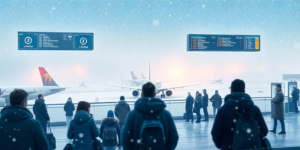The way airlines deal with flight disruptions is undergoing a big change! Instead of the usual complex and mostly manual methods, there’s a shift towards using automated solutions. This is not just about making things more efficient but also about putting passengers at the center of the solution. In this blog, we’re diving into this shift, talking about the challenges airlines face, and looking at the future where automation steps in to handle those last-minute flight issues.
Adapting to the New Era of Travel
Let’s delve into the insights from the SITA Air Transport IT Insights 2022 report:
- Airlines are evolving their operations in response to the resurgence of air travel in the post-pandemic landscape. They’re prioritizing flexibility to navigate unforeseen circumstances effectively.
- Investments in predictive analytics are enabling them to anticipate and address disruptions proactively.
- Enhancing communication among various services and stakeholders is emerging as a key focus area.
- Leveraging social media for widespread notifications is gaining traction as a communication strategy.
- Looking forward, airlines are gearing up for advanced tools like simulation capabilities and automated alerts to elevate the passenger experience to new heights.
Better Communication
Communication is key, and airlines are putting more effort into making it smoother. They are working on improving how different services and groups talk to each other. Using social media to give out important info is becoming more popular too. This means you get timely updates, making sure you’re in the know about any changes or issues. It’s all about keeping you informed and making your travel experience better.
Automated Alerts
What’s in the cards for the future? Airlines are gearing up for even more advanced tools. They’re investing in simulation technologies to plan and react better to different situations (55%). Automated predictive alerts (60%) are also in the mix, ensuring you get important updates before disruptions happen. It’s like having a heads-up before your journey, so you can be ready for whatever comes your way.
Proactive Solutions for a Smoother Ride
This shift is a game-changer. Instead of just reacting when something goes wrong, airlines are now working proactively. They’re using tech to predict, communicate, and prepare for disruptions. This isn’t just about making things more efficient; it’s about making your travel experience better. In the next parts of this blog, we’ll dive into the specific strategies airlines are using to make this happen. From using your data smartly to communicating through different channels, offering personalized deals, and connecting data for a seamless experience – we’re covering it all. Stick around to see how these strategies are reshaping your journey and setting new standards for air travel.
Reacting for Success – Key Strategies
Strategy #1: Completeness of Customer Data
Passenger satisfaction hinges on real-time notifications during disruptions. Airlines focusing on database completeness stand in the best position to meet customer demands. Communicating the impact of third-party bookings on information reception is crucial. Leveraging technology and analytics, airlines can personalize customer experiences across various touchpoints, providing customized offers and streamlined services.
Strategy #2: Multichannel Communication Channels
Navigating disruptions requires a comprehensive approach. Airlines can build trust and loyalty by proactively communicating via multiple channels, including email, SMS, mobile apps, and social media. Implementing online self-service tools empowers passengers to manage bookings independently, reducing the strain on customer service. According to SITA Air Transport IT Insights 2022, a significant 90% investment in disruption warning systems underscores the importance of effective communication.
Strategy #3: Personalization
In the dynamic air travel landscape, hyper-personalization emerges as a key strategy. Airlines are recognizing the need to treat passengers as unique individuals, leveraging comprehensive data for a centralized view. Customer Experience Management, facilitated by real-time integration with IT systems, enables tailored services based on past travel behavior. This shift not only fosters loyalty but optimizes revenues and operational efficiency.
Strategy #4: Fully Connected Data Integration
Ensuring a seamless travel experience requires interconnected data integration. Booking data must be linked with loyalty programs and CRM databases for an up-to-date passenger profile. The importance of real-time data synchronization cannot be overstated, contributing to a more informed and responsive disruption management process. Automation plays a vital role in keeping passengers informed and engaged.
Conclusion
By embracing automation and focusing on completeness of customer data, multichannel communication, hyper-personalized offers, and fully connected data integration, airlines can revolutionize disruption management. This shift promises improved customer experiences, increased loyalty, and positive impacts on the bottom line.






